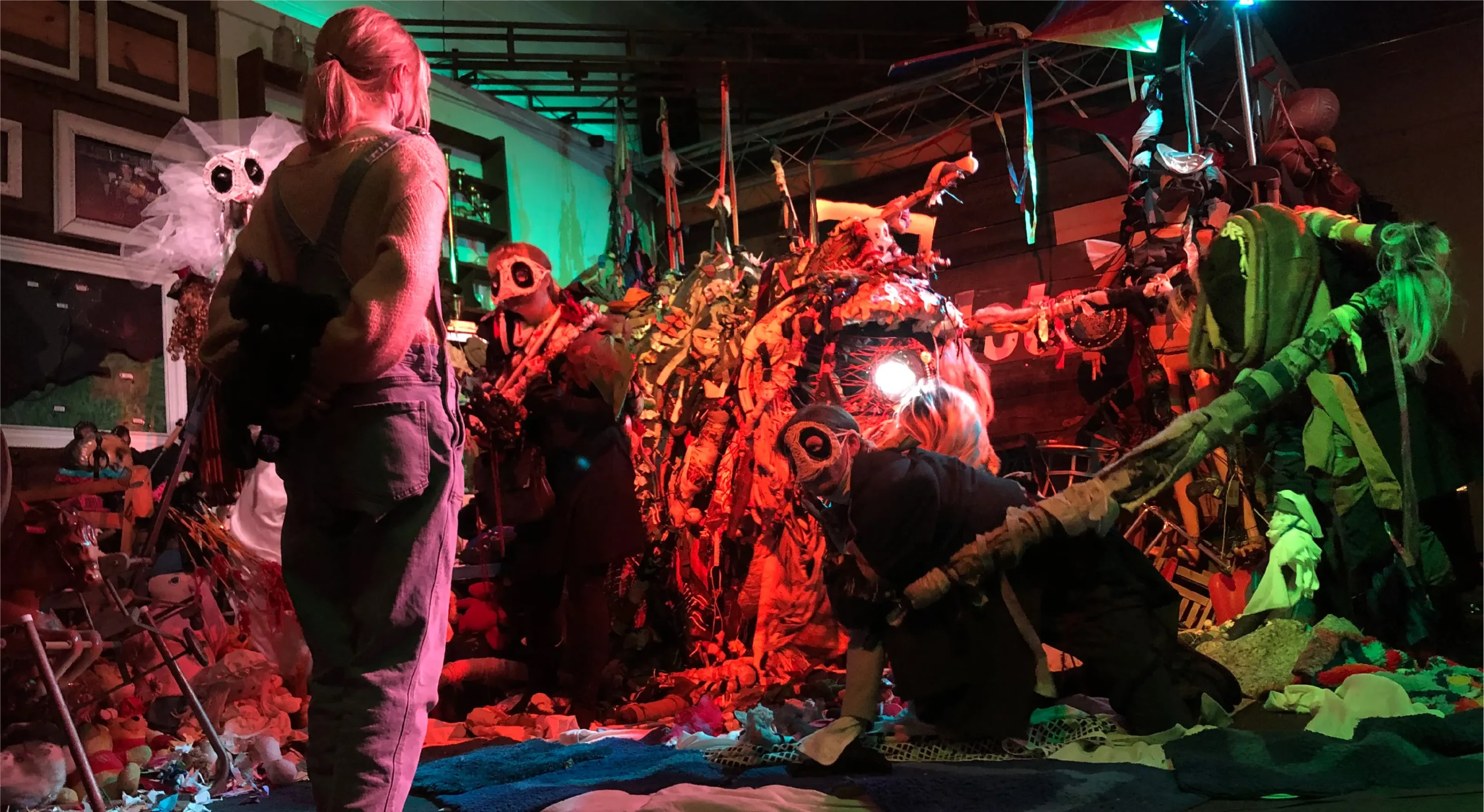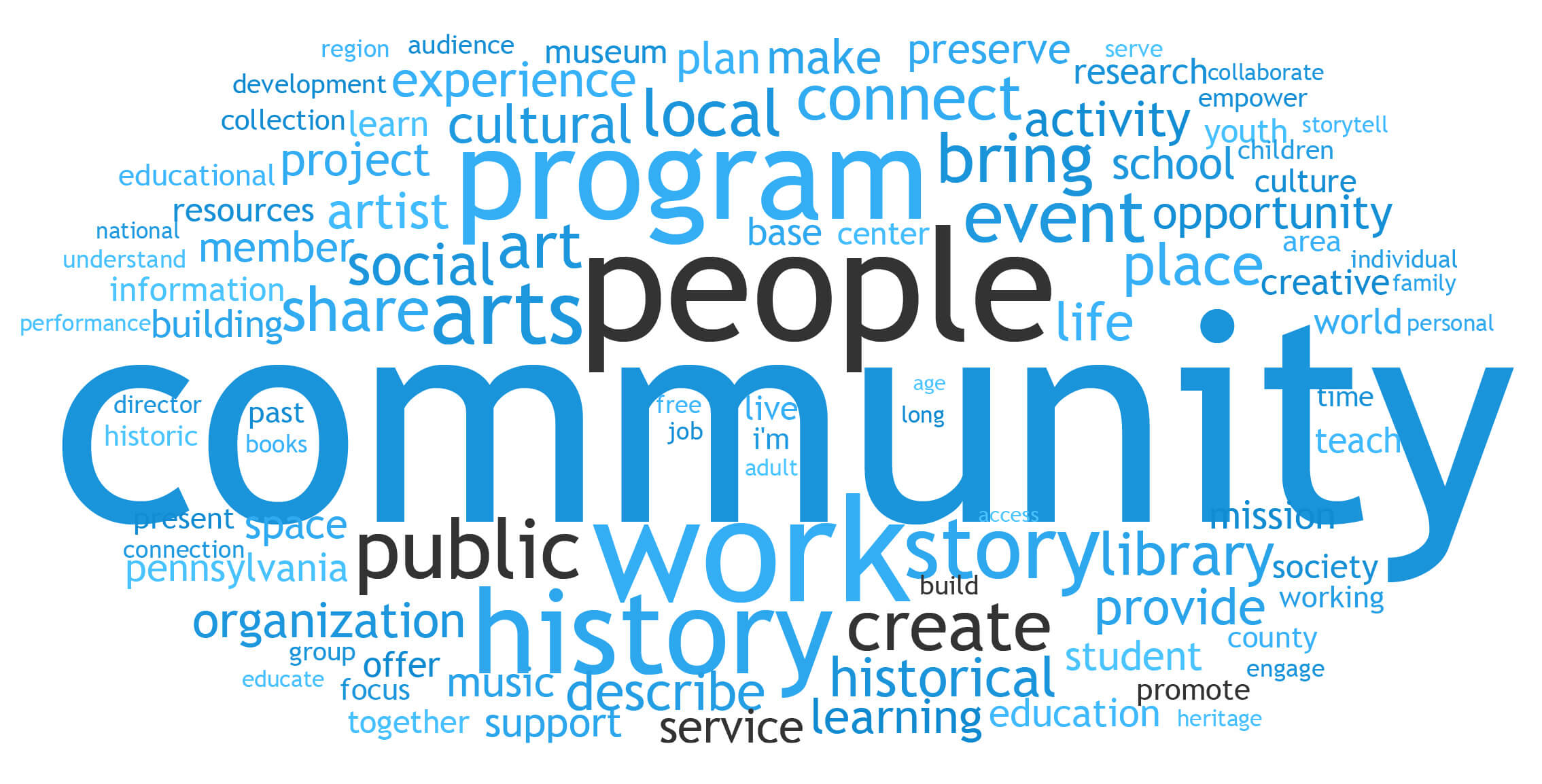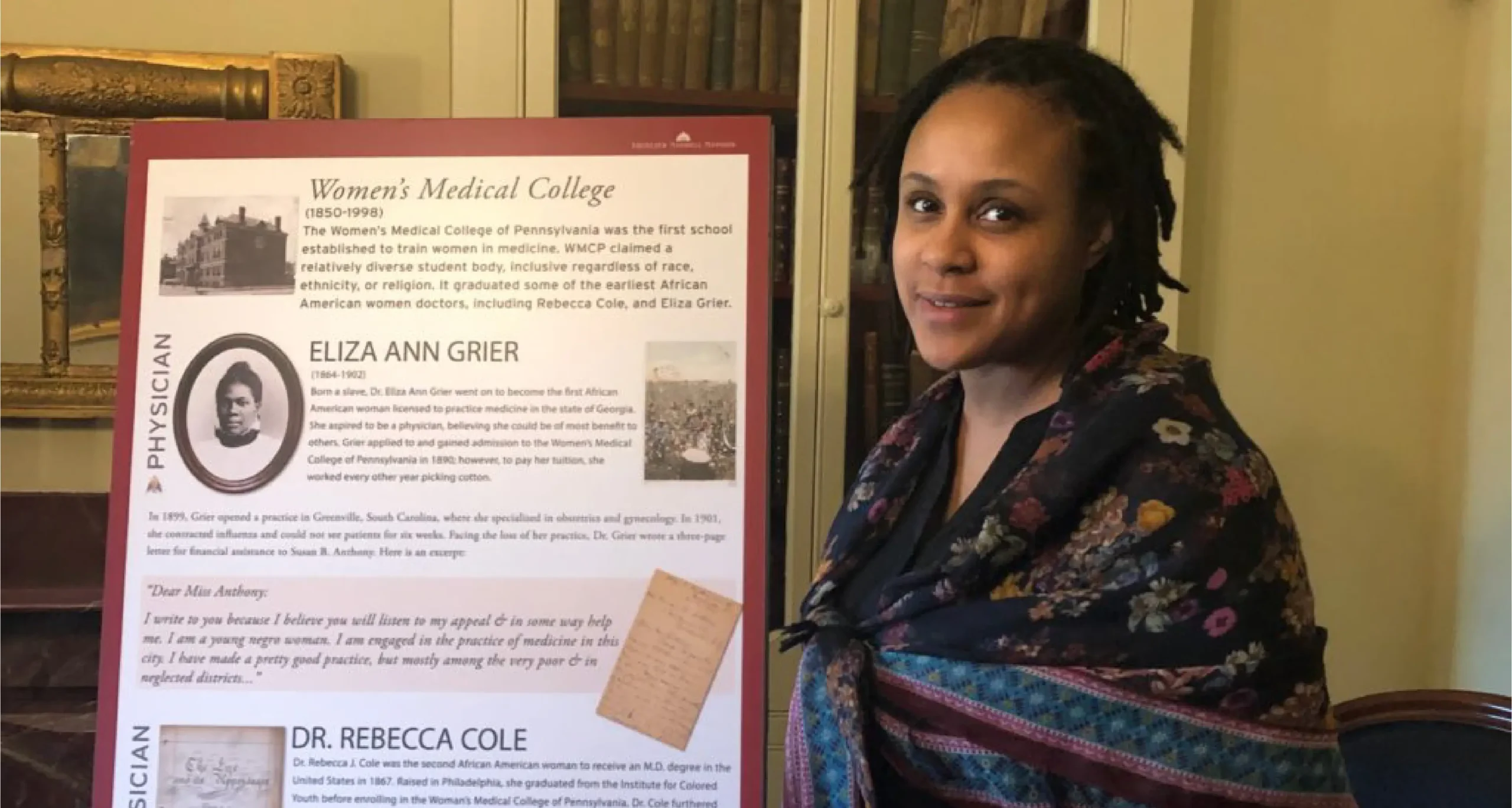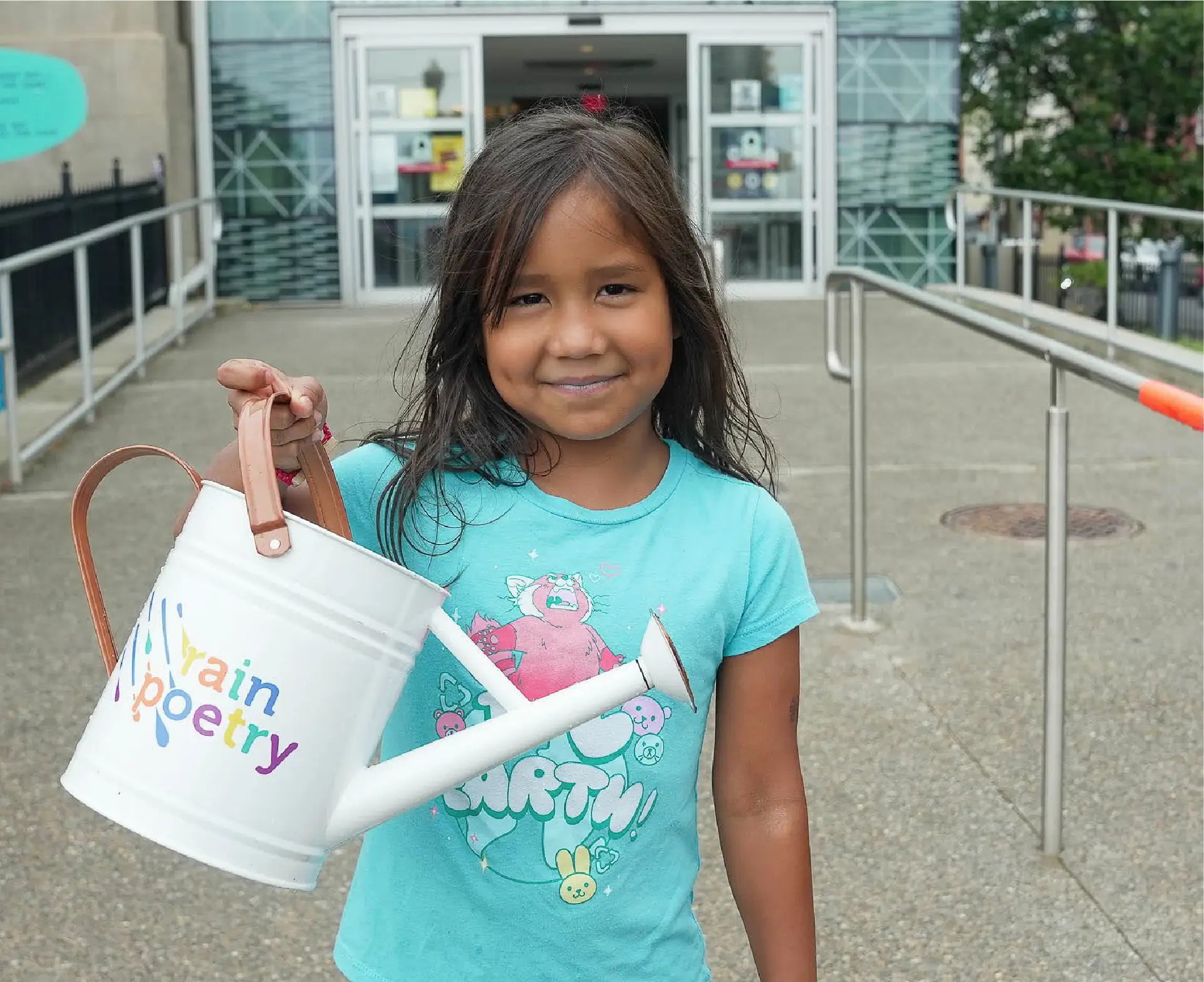Section 5 – Why is Humanities Work Important?

Practitioners often use terms other than “humanities” to describe their work, necessitating a rethinking of how our language matches practice. No matter how they’re described, the humanities are important to practitioners and their audiences because they help us discover meaning in our lives, flourish, and build our futures together.
The powerful testimonies and motivations of humanities practitioners makes the case for their value as a way of lifting our humanity to transform ourselves and communities. They are critical to solve the pressing challenges of our time, from social isolation to preservation of history, to promoting equity and justice. Taking a fresh look at the humanities in terms of personal benefits and motivations, known as a capabilities approach, offers a new way to reframe the humanities as a fundamental human right.
How practitioners describe their work
In the survey and focus groups, we asked humanities practitioners how they describe their work to others. It was important to grasp the narratives and terms employed across Pennsylvania in order to better understand the framing of this vital practice. Previous research about public perceptions showed that there is not a common understanding of the term humanities and that many associated keywords and concepts may generate more traction when describing its broader set of practices. Based on the responses, it is clear that the applied humanities is a people- and community-centered activity. There is also an overlap between arts and humanities among practitioners, who see themselves working across both domains. Practitioners see their work as a dynamic process – a way of doing that fosters positive change for the good of humanity.
{ WORDS HUMANITIES PRACTITIONERS USE TO DESCRIBE THEIR WORK }

Top themes from the participants
When exploring how humanities practitioners describe their work, we coded all the responses from the survey and explored quotes from the focus groups to determine which themes were brought up the most. The top themes were: providing a community hub, historic preservation, deepening connections to culture, and social connection. Other prominent themes included supporting youth, social justice, storytelling, and creating safe spaces.
Providing a Community Hub
Participants stated that they serve everyone in their own community as well as people in neighboring areas. Humanities often takes place in community-based spaces – not a city hall or typical space of power. These non-traditional places increase agency, power, and influence created by people, not by institutions. The public humanities provides places for people to gather together and create fellowship. They provide safe, judgment-free spaces in which people can fully embrace their sense of self and expand their horizons without limitations of time or cost. They create vital third places for diverse communities struggling to connect.
Our mission statement is to act as a community hub; a welcoming place for all people to learn, grow, and connect.”
Deepening Connections to Culture
The arts and humanities travel together, providing intergenerational transmission and preservation of culture through programs and events that are often free to the public. Respondents’ spoke of their mission to enrich humanity and the social conditions of their communities, linking the term “humanities” to denote shared humanity as a concept and a practice in the world. Art and culture are seen as intimately connected to, if not a subset of, the humanities.
[We] transmit and make known to our children and community our traditions and culture through dance.”
Historic Preservation
There is a strong current of the importance of preserving and sharing history, whether the preservation of tangible, physical history or the intangible history of cultural, social, and political narratives. Participants saw preservation as a form of advocacy: advocacy for history and the sites and resources that comprise it. The work of elevating often-suppressed or under acknowledged histories is a passion for those who value people’s knowledge of the past and lifting aspects of history that remain unknown. There is also an emphasis on how social justice intersects with history, and art makes the past come alive with fresh interpretations that appeal to new audiences.
[We] use the word preservation, and we say that in terms of preserving Centre County history and also advocacy work for the preservation of historic sites and resources.”
Social Connection
The connections among people and places fostered by applied humanities practice builds community capacity, social capital, and sets the ground for social justice. This theme unites the others, building connections across differences, whether of age, gender, race/ethnicity, or even political orientation. Art appreciation, historical preservation, and serving as a community hub advance social connection among Pennsylvanians and beyond.
We have tons of volunteers that come and pinch pierogies and make ethnic food, but it also has a connection to the community because a lot of those people are elderly that live around our property. … It keeps them from being isolated.”
What Motivates Practitioners to Do this Work
Reframing the humanities in terms of personal benefits and motivations offers a new way to think about the practice in terms of our experience, our humanity, and as a fundamental human right. We asked practitioners what motivates them to do this work, and why it is important to them. The coded survey responses highlighted their top motivations: enriching the lives of others, fostering community success, love of the work, and learning from history. Other themes included arts awareness and generating reciprocity between practitioners and audiences.
Enriching the lives of others
Being culturally responsive was an important goal and benefit, with one practitioner describing it as “critical community work” to help people understand different cultures. Some of this work is an uphill climb, especially in settings where Native American history is often forgotten or ignored. Others spoke of being a “silent champion,” opening doors for the young people who need their support, and transforming the narratives that seemingly govern some young people’s life chances. This work also was seen as saving lives and countering burnout. The humanities provides space and time to have conversations and activities that allow people to lean into their creativity, finding time and space to pursue their passions for things like history, craft, storytelling, and literature.
We’re trying to reach the largest amount of underserved people…with free musical programs to the public. So we’re trying to… enrich humanity in that way and enrich the social structure of the area also.”
Community Success
Threatened by political polarization, declining population, or frayed social connection, the humanities can be a way to knit back together community ties through positive interactions. Pursuit of community success was often framed as place-based work and was achieved through weaving strong social fabric and social connections. Respondents spoke of wanting people to feel welcome and to stay in the community despite the great changes their communities were facing, even invoking Dr. Martin Luther King Jr.’s “beloved community” as a goal.
My love of this place, this land and all its living beings, is the main motivation. I also have hope that some of the stories we tell will make a difference for the future health of this place.”

Love of the Work
One of the most affecting themes in the research was the love and dedication with which practitioners pursued humanities work. They spoke of humanities work providing a sense of purpose and belonging. For some, this passion took the form of a love of learning and of sharing histories and stories across time and generations. The goals of social and environmental justice animate the work of many humanities practitioners. Many of the participants spoke of the work as a mission and a calling, but it takes an incredible amount of resources to do this job well.
It would be easier to ask what doesn’t motivate me to do this work. This is the work; what gets me up in the morning and inspires me.”
Learning from History
Many practitioners are motivated to do this work to learn, and help others learn, from history. One theme is the desire to advance new narratives that can recover untold or suppressed histories, and support new understandings of people and place throughout Pennsylvania while connecting and reconnecting individuals in their communities. This is important and challenging work, especially in political climates that are fraught with many forms of division.
I feel strongly that connecting to our shared history is an enterprise in civic action.”
Humanities work is vital, but is there a marketing problem?
Survey respondents rarely use the word “humanities” to describe their work, except when talking to funders, applying for grants, or talking about human rights and human flourishing. Many associate it with subjects like history and other academic disciplines. They also find the term alienating to their audiences and reflective of gatekeeping in academia.
This supports other research about a general lack of understanding about the word. The humanities have a branding problem and need to be reframed in a way that brings them to life in the mind of the public as education for life – not only a career – and a means to solve grand challenges of our time.
I’d say it’s human-centered work. I’ve never actually used the word humanities, but I always end up using the word like humanity.”
{ PRACTITIONERS WHO USE THE TERM “HUMANITIES” WHEN DESCRIBING THEIR PROJECTS OR PROGRAMS }
Making the case for the humanities
Building a case for support of the humanities is vital, in a context where they are sometimes seen as in decline relative to other fields or a “frill.” We can start by connecting our language to the real world experiences and motivations of practitioners and the individual and community benefits of this work.
We have focused on STEM [science, technology, engineering and mathematics] for so long that we often forget about the humanities to our detriment.”
Benefits of the work
Participants mentioned intrinsic motivations for doing humanities work 2.6 times for every 1 time they mentioned extrinsic values. These intrinsic benefits (which provide meaning, pleasure, cognitive growth, increased empathy, communal understanding, and social bonds) can be both individual and communal. Most arts and culture advocacy focuses on important extrinsic benefits, like economic growth and test scores, and advocates will hone their messages accordingly to resonate with those who control the distribution of funding resources. Yet humanities clearly possesses both intrinsic and extrinsic impacts. When these are set against each other in a binary or a hierarchy that one is better than the other, they are not representative of the full range of benefits of the humanities.
It empowers people to see themselves as having the skills needed to connect with others, express themselves, and build resistance against people who seek to exploit or oppress them.”
Human Flourishing & Happiness: A Capabilities Approach
The humanities help us to discover meaning in our lives, prosper, and build our futures together. The capabilities approach offers a new way of looking at the incredible value of the humanities, seeing them as a fundamental human right. It is a belief grounded in recent research that there are certain qualities of life that are fundamental to human flourishing and happiness beyond solely economic metric. Individual and community well-being require freedom to engage in humanities activities, allowing people to realize their potential and express their humanity. This promotes social justice, transformation, and the empowerment of communities.

The capabilities approach is a belief that there are certain qualities of life that are fundamental to human flourishing and happiness, and need to be fostered among all people in order to allow them to live a good life with meaning and agency for themselves and their community.
The approach further aligns with the UNESCO’s Universal Declaration of Human Rights from 1948, which states that, “Everyone has the right freely to participate in the cultural life of the community, to enjoy the arts and to share in scientific advancement and its benefits.” As the arm of the United Nations charged with international cooperation, knowledge sharing, and mutual understanding, UNESCO champions everyone’s right to culture as part of human development. By focusing on human flourishing as a key goal of the humanities, it is possible to link the humanities with the happiness we experience when we live a life of meaning and purpose, a focus on living the good life through humanities inquiry and practice. This is humanities for the benefit of humanity, a people-centered effort that reconnects us with the best elements of our shared human past, and leads towards a more sustainable future.
Sharing experiences and stories as well as creating new ones together fosters a more connected and resilient community; provides opportunity to learn and gain new perspectives, and develops a sense of community that is essential to well-being.”